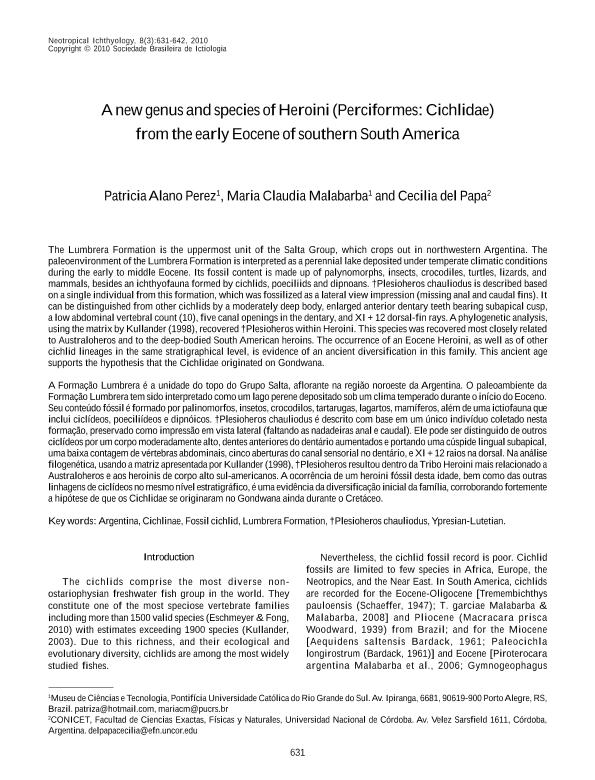Mostrar el registro sencillo del ítem
dc.contributor.author
Perez, Patricia Alano
dc.contributor.author
Malabarba, Maria Claudia
dc.contributor.author
del Papa, Cecilia Eugenia

dc.date.available
2018-08-08T17:12:20Z
dc.date.issued
2010-11
dc.identifier.citation
Perez, Patricia Alano; Malabarba, Maria Claudia; del Papa, Cecilia Eugenia; A new genus and species of Heroini (Perciformes: Cichlidae) from the early Eocene of southern South America; Sociedade Brasileira de Ictiologia; Neotropical Ichthyology; 8; 3; 11-2010; 631-642
dc.identifier.issn
1679-6225
dc.identifier.uri
http://hdl.handle.net/11336/54590
dc.description.abstract
The Lumbrera Formation is the uppermost unit of the Salta Group, which crops out in northwestern Argentina. The paleoenvironment of the Lumbrera Formation is interpreted as a perennial lake deposited under temperate climatic conditions
during the early to middle Eocene. Its fossil content is made up of palynomorphs, insects, crocodiles, turtles, lizards, and mammals, besides an ichthyofauna formed by cichlids, poeciliids and dipnoans. †Plesioheros chauliodus is described based
on a single individual from this formation, which was fossilized as a lateral view impression (missing anal and caudal fins). It can be distinguished from other cichlids by a moderately deep body, enlarged anterior dentary teeth bearing subapical cusp,
a low abdominal vertebral count (10), five canal openings in the dentary, and XI + 12 dorsal-fin rays. A phylogenetic analysis, using the matrix by Kullander (1998), recovered †Plesioheros within Heroini. This species was recovered most closely related to Australoheros and to the deep-bodied South American heroins. The occurrence of an Eocene Heroini, as well as of other cichlid lineages in the same stratigraphical level, is evidence of an ancient diversification in this family. This ancient age supports the hypothesis that the Cichlidae originated on Gondwana.
dc.format
application/pdf
dc.language.iso
eng
dc.publisher
Sociedade Brasileira de Ictiologia

dc.rights
info:eu-repo/semantics/openAccess
dc.rights.uri
https://creativecommons.org/licenses/by-nc-sa/2.5/ar/
dc.subject
Argentina
dc.subject
Cichlinae
dc.subject
Fossil Cichlid
dc.subject
Lumbrera Formation
dc.subject.classification
Meteorología y Ciencias Atmosféricas

dc.subject.classification
Ciencias de la Tierra y relacionadas con el Medio Ambiente

dc.subject.classification
CIENCIAS NATURALES Y EXACTAS

dc.title
A new genus and species of Heroini (Perciformes: Cichlidae) from the early Eocene of southern South America
dc.type
info:eu-repo/semantics/article
dc.type
info:ar-repo/semantics/artículo
dc.type
info:eu-repo/semantics/publishedVersion
dc.date.updated
2018-08-02T14:49:27Z
dc.identifier.eissn
1982-0224
dc.journal.volume
8
dc.journal.number
3
dc.journal.pagination
631-642
dc.journal.pais
Brasil

dc.journal.ciudad
Porto Alegre
dc.description.fil
Fil: Perez, Patricia Alano. Pontificia Universidade Católica do Rio Grande do Sul; Brasil
dc.description.fil
Fil: Malabarba, Maria Claudia. Pontificia Universidade Católica do Rio Grande do Sul; Brasil
dc.description.fil
Fil: del Papa, Cecilia Eugenia. Consejo Nacional de Investigaciones Científicas y Técnicas. Centro Científico Tecnológico Conicet - Córdoba. Centro de Investigaciones en Ciencias de la Tierra. Universidad Nacional de Córdoba. Facultad de Ciencias Exactas Físicas y Naturales. Centro de Investigaciones en Ciencias de la Tierra; Argentina
dc.journal.title
Neotropical Ichthyology

dc.relation.alternativeid
info:eu-repo/semantics/altIdentifier/url/http://ref.scielo.org/r28skq
dc.relation.alternativeid
info:eu-repo/semantics/altIdentifier/doi/http://dx.doi.org/10.1590/S1679-62252010000300008
Archivos asociados
